Kabocha Pork Stir-Fry is a simple yet satisfying dish you’ll enjoy when kabocha squash is in season. It’s a one-pan wonder for a weeknight dinner!
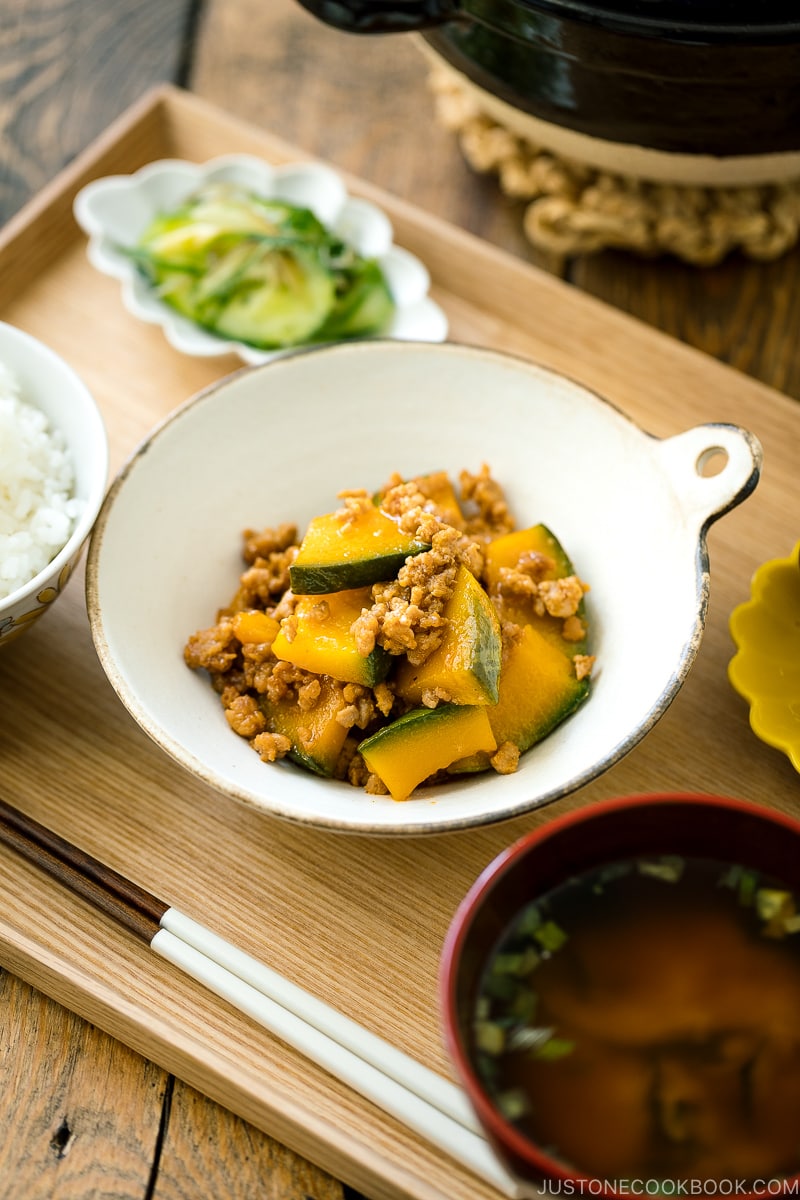
Fall is here and all I can think about is all things kabocha. Soups, desserts, salads – it can do it all. In Japan, kabocha is enjoyed year-round, but here in the US, you can definitely spot this Japanese pumpkin in farmers’ markets, local pumpkin growers, and mainstream grocery stores when it’s in season.
Today I’m sharing a healthy, delicious, yet lifesaving recipe – Kabocha Pork Stir-Fry (かぼちゃのそぼろ炒め).
Table of Contents
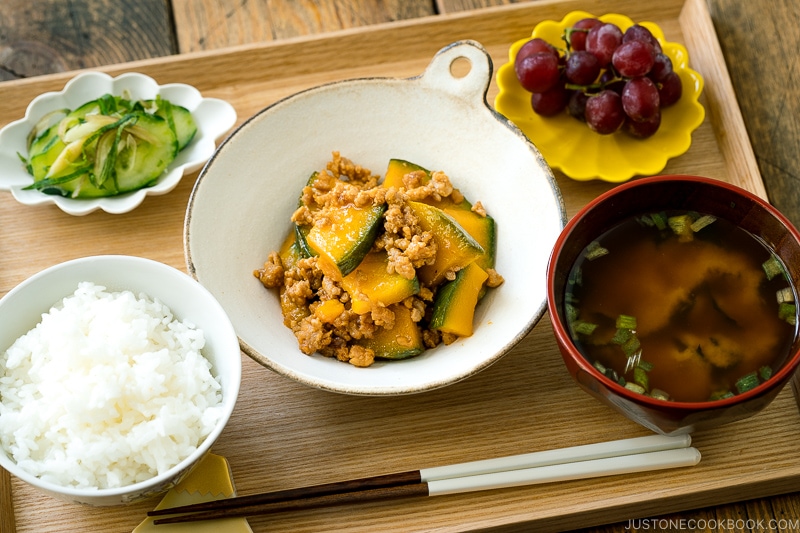
What is Kabocha?
Kabocha (かぼちゃ, 南瓜) is a type of winter squash, a Japanese variety of the species Cucurbita maxima. In North America, it’s also called kabocha squash or Japanese pumpkin.
The green outer skin is tough, but you’d be surprised by the outstanding sweetness of the deep yellow-orange flesh on the inside. Kabocha has a rich texture and flavor that is similar to a sweet potato and pumpkin combined. Some even describe the flavor as close to roasted chestnut.
We treasure the squash so much that it is used in Japanese cooking where it is simmered in dashi or soups, stewed, stir-fried, deep-fried into tempura, or used in salads and desserts.
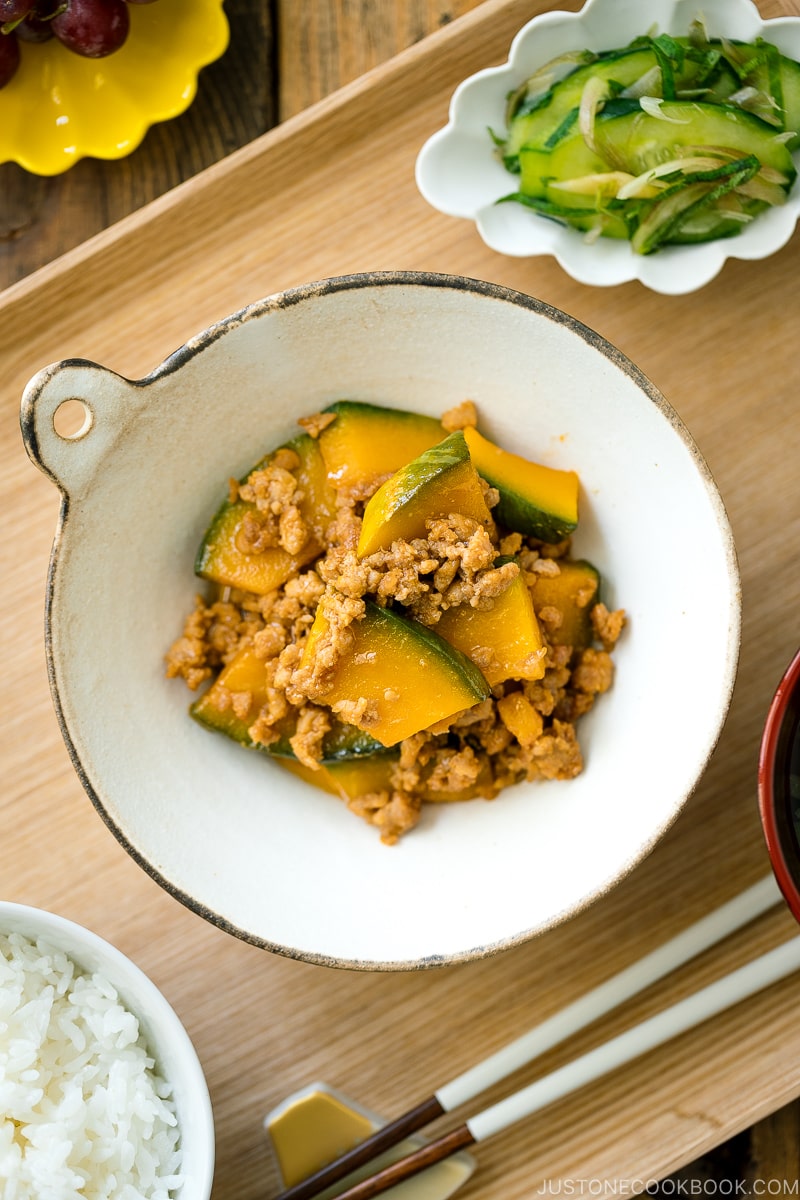
Why You’ll Love Kabocha Pork Stir-Fry
- Easy and quick to prepare!
- Full of flavor — Make sure to cook extra rice for the second serving.
- Good make-ahead meal — Make a big batch and freeze it for later. It’s perfect for emergency days.
- Nutritious and packed with protein.
- Customizable seasonings — You can make it sweeter or spicier, to your liking.
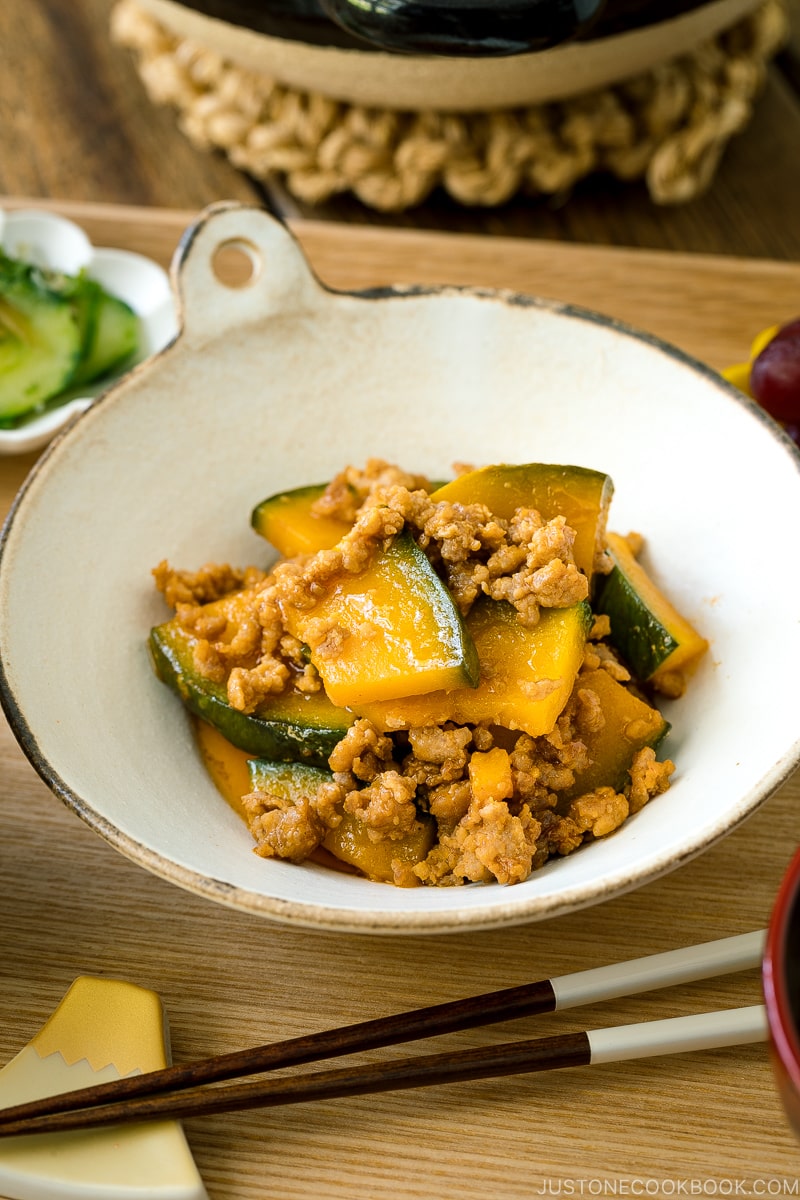
Ingredients You’ll Need
- Kabocha squash
- Ground pork — ground chicken or turkey would also work; for vegetarians, substitute with seitan or minced mushrooms
- Stir-fry seasoning — sake, soy sauce, oyster sauce, sugar, and gochujang (Korean chili paste or other chili sauce; use miso for a non-spicy version)
How to Make Kabocha Pork Stir-Fry
- Marinate the ground meat in a bowl with the pork marinade.
- Cut the kabocha into thin slices and pre-cook in the microwave covered with a paper towel.
- Stir-fry the pork in a large skillet over medium heat until it’s almost done.
- Add the kabocha and cover to steam until tender.
- Add the pork seasoning and toss everything together.
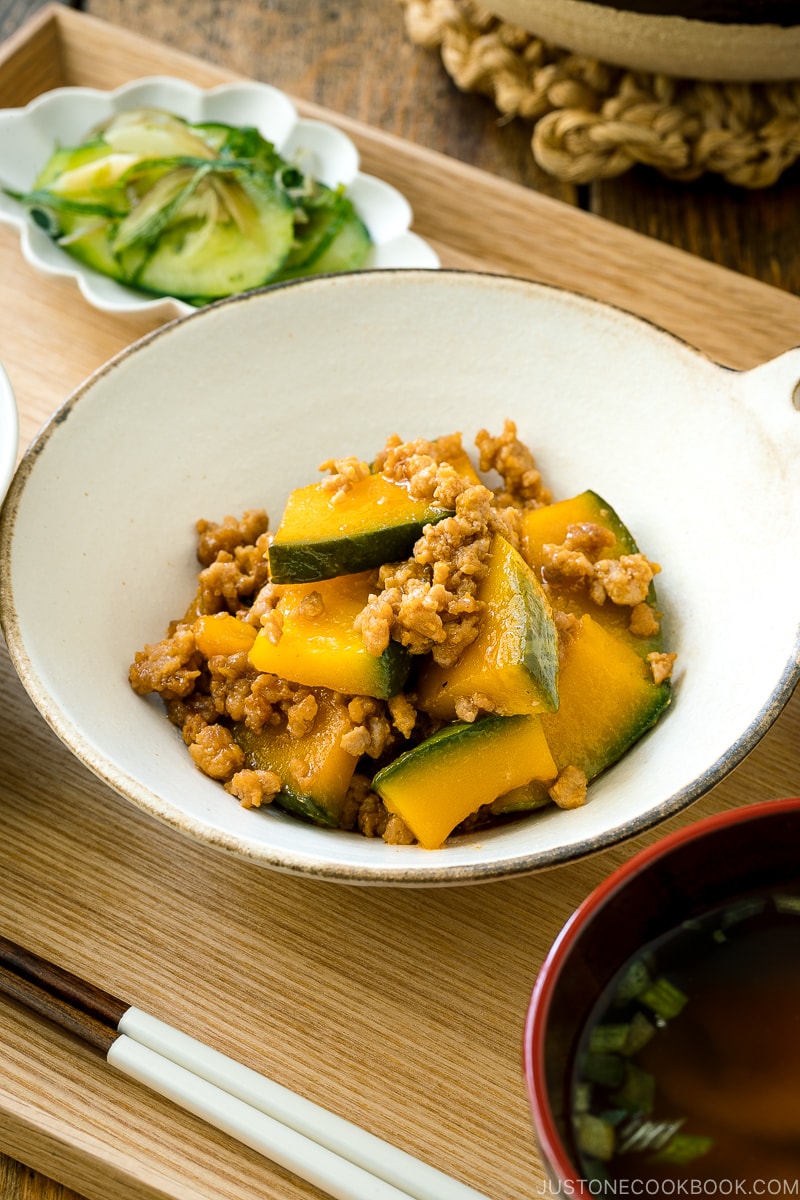
Cooking Tips
Tip #1: Marinate the Meat
Ground meat, especially pork, can get dry as moisture and juice escape during cooking. Coating the meat with potato starch (or cornstarch) helps to prevent this. A quick 5-10 minutes is all you need while prepping other ingredients.
Sake, soy sauce, and potato starch is a common pork marinade for the meat. You do not need a lot. Just a thin coating is more than enough to give the meat a silky coating. Too much potato starch could make the sauce too thick.
Tip #2: Pre-cook the Kabocha
Kabocha takes some time to cook through. When it’s done cooking, it can break easily. Therefore, I highly recommend pre-cooking the kabocha to give it a head start. Then, add the kabocha to the dish and cook it together with other ingredients so it can soak up all the flavors.
Tip #3: Adjust the Seasonings
Feel free to adjust the spiciness and sweetness to taste. You can completely omit gochujang from the sauce mixture if you are not used to spicy food. I slowly increased the amount of gochujang so my kids developed a tolerance over time. This dish also works great with a bit more sweetness. However, if you prefer, you can omit the sugar completely to keep it savory.
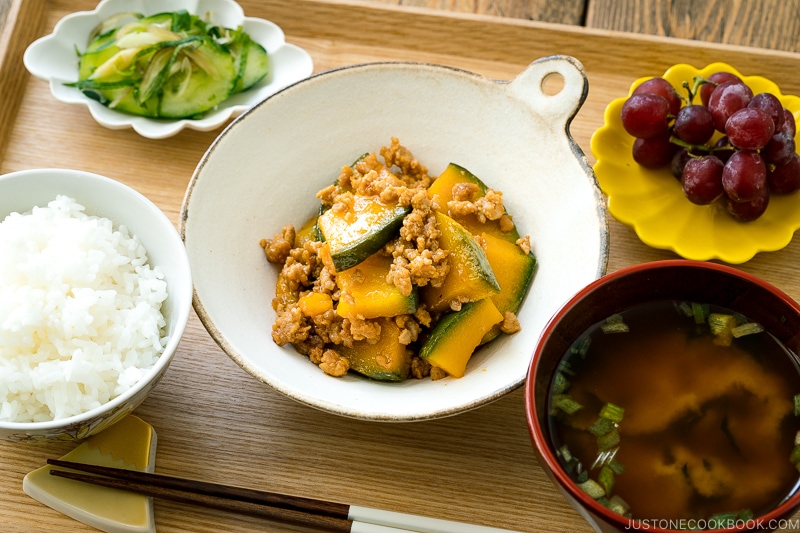
Wish to learn more about Japanese cooking? Sign up for our free newsletter to receive cooking tips & recipe updates! And stay in touch with me on Facebook, Pinterest, YouTube, and Instagram.

Kabocha Pork Stir-Fry
Video
Ingredients
- 1 clove garlic
- 6 oz ground pork (or use turkey or chicken; substitute seitan or minced mushrooms for vegetarian)
- ¼ kabocha squash (11 oz, 312 g; or use butternut or acorn squash)
- 1 Tbsp neutral oil
For the Pork Marinade
- ½ tsp soy sauce
- 1 tsp sake
- 1 tsp potato starch or cornstarch
For the Stir-Fry Seasoning
- 1 Tbsp sake
- 1 Tbsp soy sauce
- 2 tsp oyster sauce
- 1 tsp gochujang (Korean chili paste) (you can substitute it with other chili sauce for spicy version; or use miso for non-spicy version)
- 1 tsp sugar
Instructions
- Gather all the ingredients. Cut 1 clove garlic into thin slices.
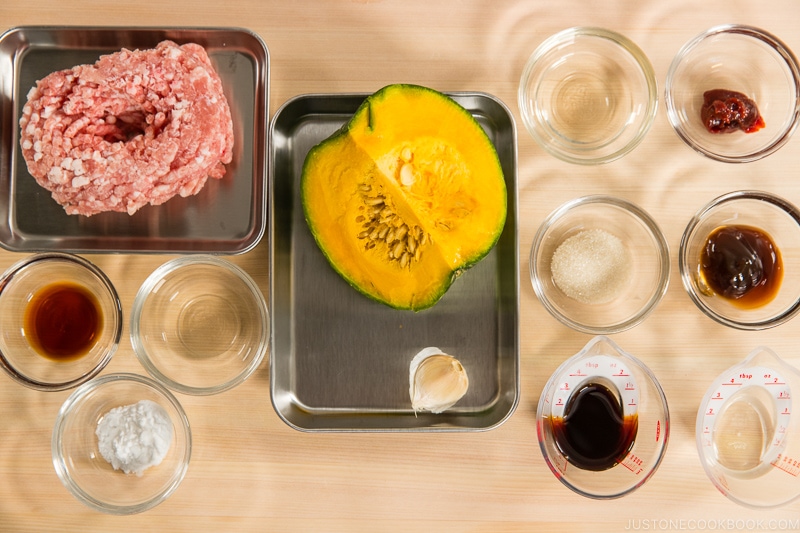
To Make Pork Marinade
- In a medium bowl, combine ½ tsp soy sauce, 1 tsp sake, and 1 tsp potato starch or cornstarch and mix it all together.
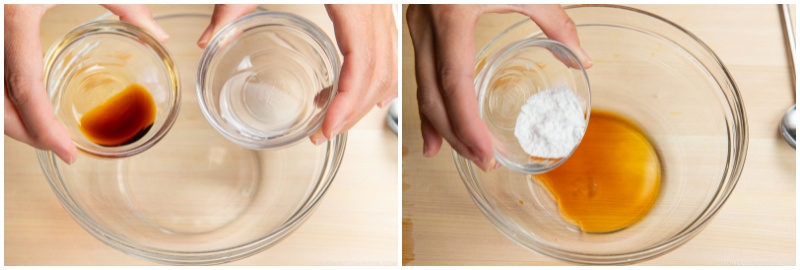
- Add 6 oz ground pork and mix well. Set aside.
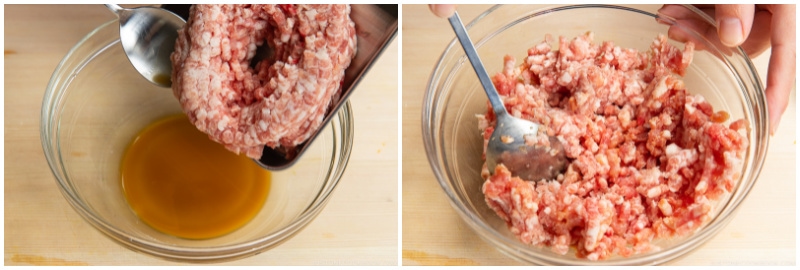
To Make the Stir-Fry Sauce
- In a small bowl, combine 1 Tbsp sake, 1 Tbsp soy sauce, 2 tsp oyster sauce, and 1 tsp gochujang (Korean chili paste).
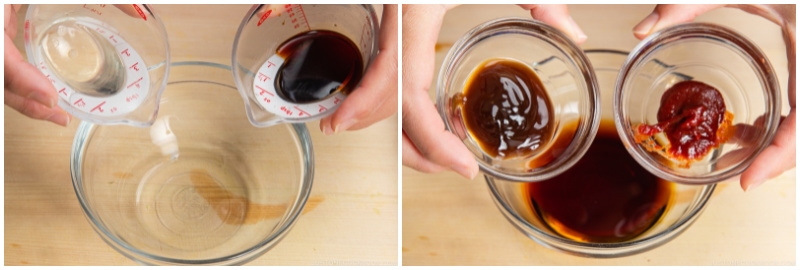
- Add 1 tsp sugar and mix all together. Set aside.
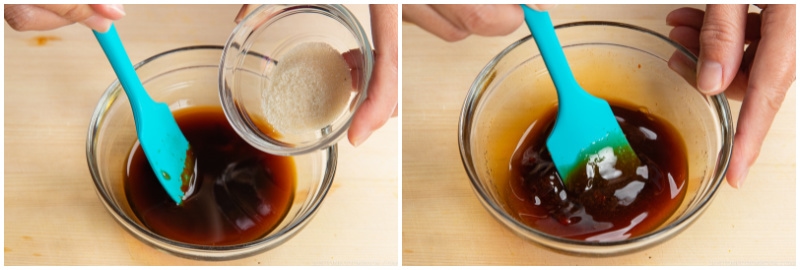
To Prepare Kabocha
- With a spoon, remove the seeds from ¼ kabocha squash. Cut the kabocha block in half so it‘s smaller and easier to slice. Tip: We eat kabocha skin in Japan! If there are tough scars on the skin, shave them off. We remove the skin only when you want to feature the kabocha‘s yellow-orange color, such as kabocha soup or kabocha pie or pudding (the color won‘t be pretty if you mix in the green skin).
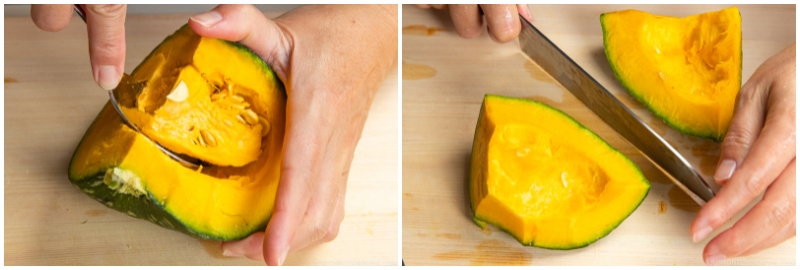
- Cut the kabocha into thin slices, roughly ⅛ inch (3 mm) thick. If the kabocha pieces are too big, cut them in half.
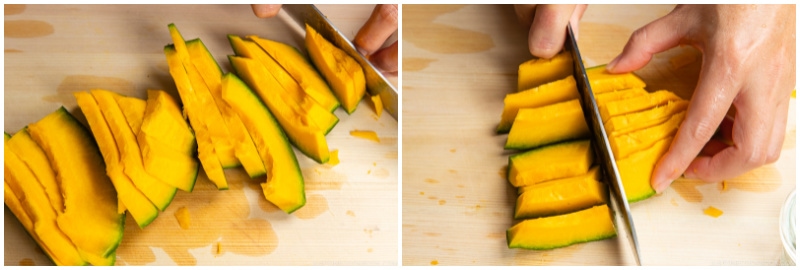
- In a microwave-safe glass container, put kabocha slices and 1 Tbsp water. Place a paper towel on top and microwave for 2 minutes (depending on your microwave wattage).
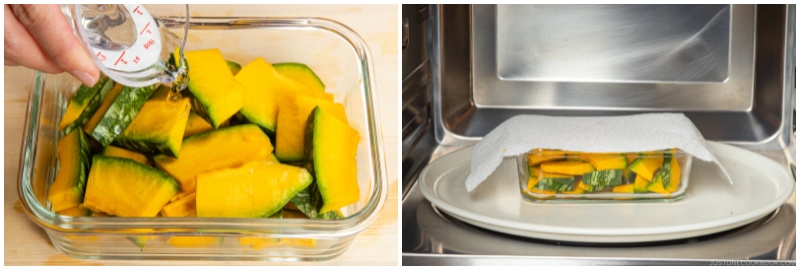
- Check the kabocha‘s doneness with a wooden skewer. It should be 80% cooked through (as we will stir-fry later). Do not overcook them because they will break into pieces while stir-frying.
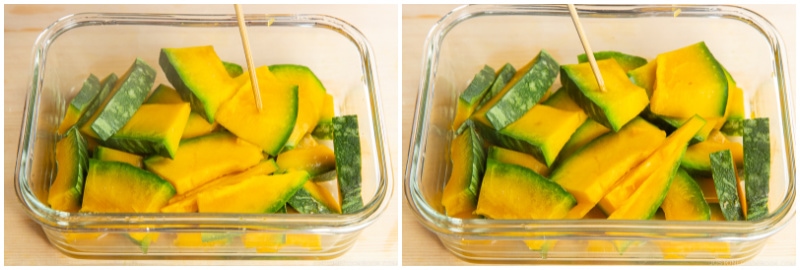
To Stir-Fry
- In a large frying pan, heat 1 Tbsp neutral oil on medium heat and cook the garlic until fragrant.
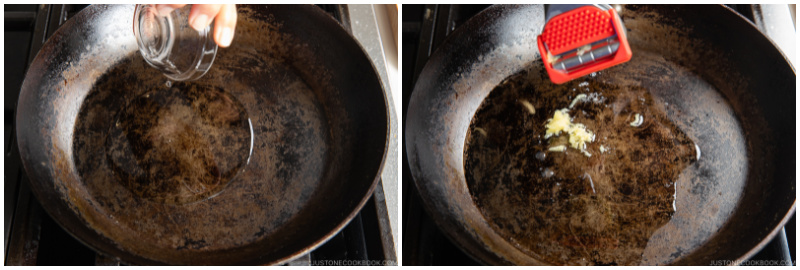
- Add the marinated meat and cook until no longer pink.
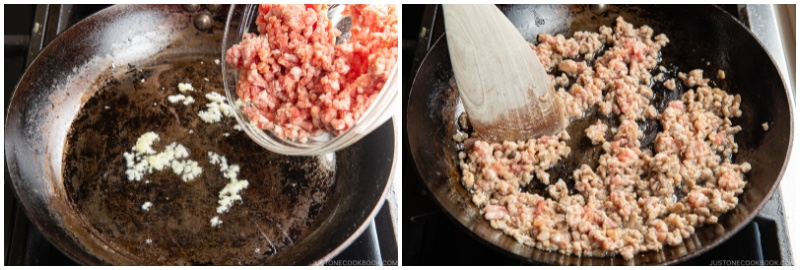
- Add the kabocha slices and coat them with oil.
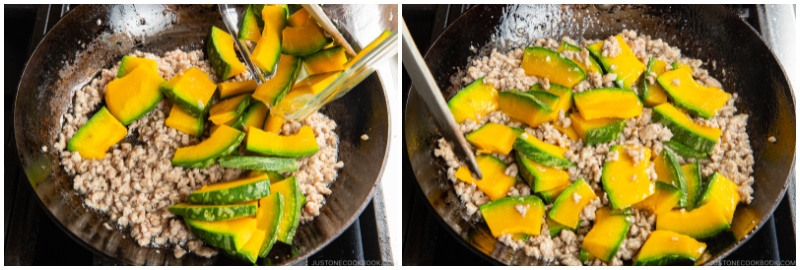
- Cook covered on low heat until the kabocha is fully cooked, roughly 5 minutes.
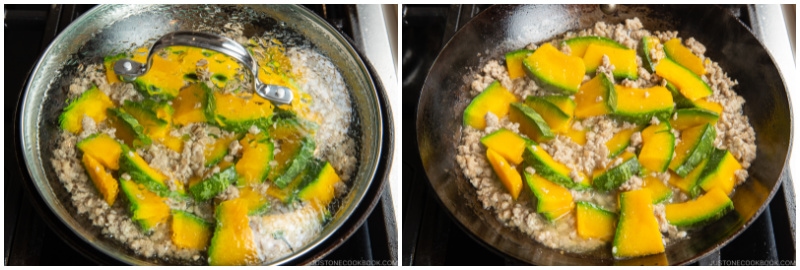
- Insert a skewer to check the doneness. Add the stir-fry seasoning.
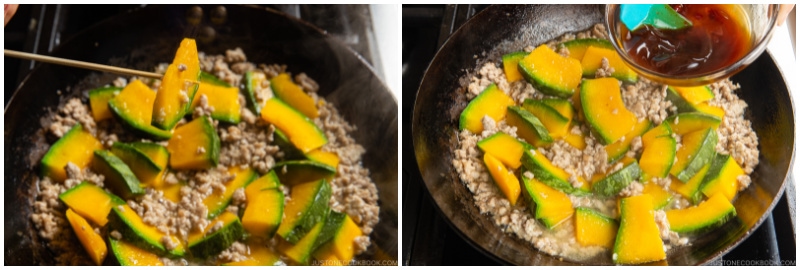
- Increase the heat and stir-fry to coat the ingredients with the sauce. When the sauce has reduced, it‘s done.
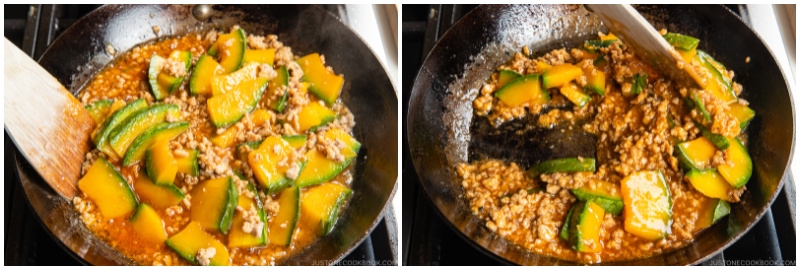
- Transfer to a serving dish. Enjoy!
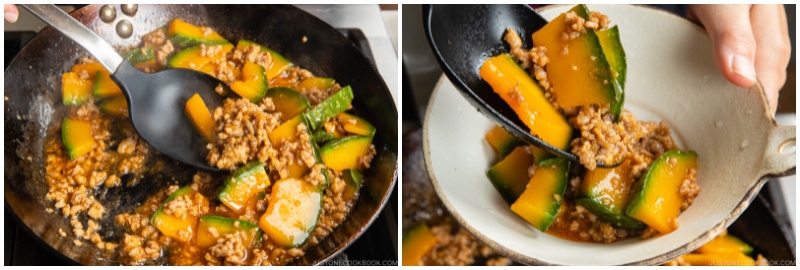
To Store
- You can keep the leftovers in an airtight container and store in the refrigerator for up to 3 days or in the freezer for a month.
Nutrition
Editor’s Note: This post was originally published on September 19, 2011. The post has been updated with new content, new images, and new video in September 2021.
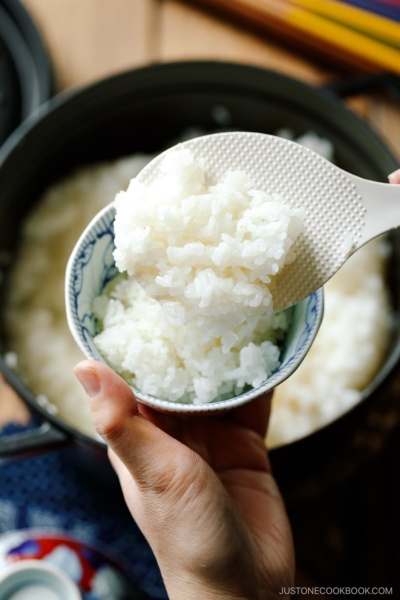
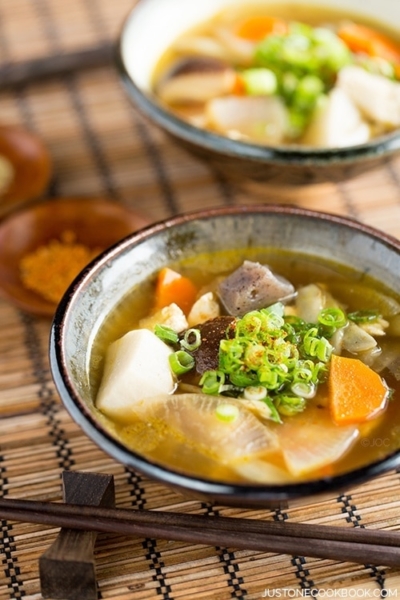
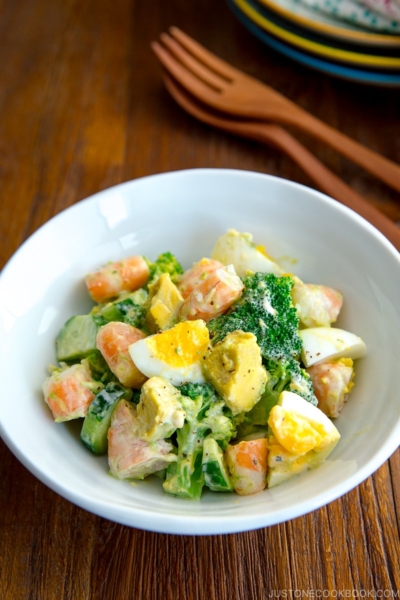
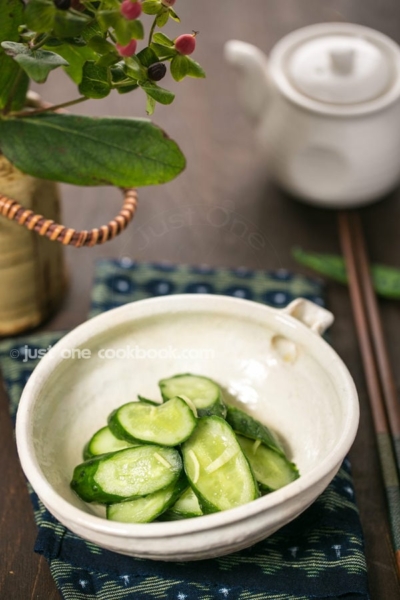




This has quickly become one of our favorite, go-to recipes. My husband and I love it! We are trying to watch our red meat intake so replaced the pork with ground turkey. It’s still delicious and so easy to make. Kabocha is the best!
Hi Rei! We are so happy to hear you and your husband enjoyed the dish!
Thank you very much for trying Nami’s recipe and sharing your cooking experience with us.
Hello,
If i don’t have a micowave what would be the best way to cook the squash?
I ask cuz there must be a reason like the squash not grilled, or to stay moist?
(Sorry for my english i’m french speaker from Montreal 👋🏼)
Thank you 🙂
Hi Mej! Thank you very much for trying Nami’s recipe!
We recommend steaming the Kabocha until cooked through about 80%.
We hope this is helpful.🙂
I made this recipe tonight and oh my goodness, it is the ultimate fall comfort food! The gojuchang gives it nice heat. I will be making this often in the coming months. It makes a great dinner served with rice and chopped green onion on top. Thank you,Nami!
Hi MARY! Awesome! Nami and JOC team are so happy to hear you enjoyed this dish!
Thank you very much for trying Nami’s recipe and for your kind feedback.😊
This looks great – and I just recently bought some squash, and have almost everything else at home already. Except for the oyster sauce… is there a good substitute for it?
Thanks!
Hi Yael! Thank you very much for your kind feedback!
You can try Teriyaki sauce or Hoisin sauce and adjust it to your taste.
We hope this works well for you!
Great success! Thank you!
Hi Yael! Awesome! Thank you very much for your kind feedback!💞
The sauce is delicious!!! I didn’t have the ground pork or the kabocha so I used chicken thighs chopped into 1 in pieces and snow peas that I blanched and added at the end. It was perfect. Even my picky hubs loved it! I served it with the amazuzuke pickle recipe. YUM. Will definitely make again!
Hi Nikki!
We are so happy to hear you enjoyed this sauce with chicken and snow peas!
Thank you very much for trying this recipe and for your kind feedback.
I made this today for lunch and it’s so yummy! Great balance of flavors! My family loves Kabocha 🙂
Hi Lauren! I’m so happy to hear you enjoyed this recipe. Thank you for your kind feedback! 🙂
If I didn’t want to use the microwave and just cook the kabocha on the stove, how would I adjust the time?
You can cook the kabocha in boiling water or steam until firm but tender (80% cooked through). If you cook too long, it gets mushy. You will still need to stir fry, so you don’t have to boil till soft. 🙂
Hi
I like your recipes, I try it hear in Nigeria for the Japanese in Honda company and they like it. thank you.
Hi Elizabeth! So happy to hear that. Thank you so much for your kind feedback! 🙂
Thank you for the recipe with Kabocha squash. Do you peel the squash?
Hi Ali! Most of the time, Japanese use the skin as it has nice nutrients in it. 🙂 Also it protects the orange part becoming too soft and mushy.
Raymund, the Filipino word “calabasa” is (of course) an adaptation of the Spanish identical-meaning “calabaza”. As for kabocha, while various theories exist, and although the modern Portuguese word is totally different, I suspect may have a lot to do with a (possibly conjectural) old Portuguese *cabacha* with the loss of intervocalic l typical of Portuguese evolutionary phonetics. Which would make sense since pumpkins may well have been introduced to Asia from their native America by Iberian traders. So all four worlds would ultimately go back to the Arabic qara yabisa, “dry gourd” -a nice example of words travelling around the world.
Fascinating story, Steven! Thanks for sharing!
Hi Nami,
Kabocha is now one of my favorite vegetables. I made the kabocha stir fry and it was delicious. I did peel the skin off after slicing the kabocha. I also found your recipe for kabocha soup and will try that next. Thanks.
Hi Darlene! I hope you like the soup too, as it’s my favorite kabocha recipe. 🙂 Thanks so much for your kind feedback! xo
Hi Nami,
I made this other day and it was so delicious! The gochujang gave it such spice and depth and complimented the sweet pumpkin perfectly. As always, thanks for sharing!
Hi Janice! I’m’ so happy to hear you liked it! Thank you for your kind feedback! xo
I tried this recipe this evening. It was so good. The flavor was just right. My Morher used to make this for my Father and I didn’t realize it was so easy. We also had the spicy bean sprouts…great!
I’m not a “follow the recipe” person. Normally, I just estimate my ingredients. But your recipes, instruction and illustrations are so easy to follow that it makes for an enjoyable experience.
I’m so glad that my cousin “liked” your post so that I can enjoy too.
By the way, we share something in common, my middle name is Namiko too. 😉
Thank you,
Alesia
Hi Alesia! I’m so happy to hear you liked it! Isn’t it simple yet it tastes so delicious? Thanks so much for writing your kind feedback!
I’m glad to hear you like the way I write my recipes. I think… my English is not as good so my sentence structure and words are very simple. LOL!!!
Please send my best regard to your cousin!
And it’s so cool we have the same name!!! Do you know how you write yours? Mine is 菜美子, but a lot of people have 奈美子. 🙂
I was wondering what would be a substitute for Gochjang. Would miso work for it?
Hi lele! Yes, miso ( + a bit of any kinds of chili sauce if you like spicy, otherwise just miso) would work perfectly. 🙂
Hi!
I love kabocha, but we don’t grow it at my farm. We have buttercup squash which is similar in flavor and texture so I will use that 🙂 One question: I don’t have a microwave oven, so I was thinking of steaming it on the stove — Have you tried that or would a different cooking technique be better?
Hi Rebeca! How nice to have your own farm! Microwave method is a shortcut so please parboil kobocha (or buttercup squash in your case) as you normally do. But make sure not to overcook or else it will easily break while you stir fry. Enjoy!